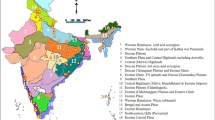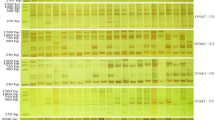Abstract
Erythropalum scandens Blume, an emerging medicinal plant with great potential for drug development, also possesses high edible value. In this study, we investigated the genetic diversity of the germplasm of E. scandens obtained from different geographical locations using inter simple sequence repeat (ISSR) markers. For this purpose, 18 ISSR primer pairs with a distinct background and adequate polymorphism were selected. We established an optimal ISSR–PCR reaction system (20 µL) with the following parameters: 1 µL DNA template (60 ng µL−1), 1.2 µL primers (10 µmol µL−1), 10 µL MasterMix, and 7.8 µL H2O. A total of 183 loci were amplified using the 18 primer pairs, of which 121 (66.12%) indicated polymorphism. Moreover, 34 germplasms of E. scandens exhibited genetic similarity coefficients ranging from 0.7104 to 0.9563, genetic distances ranging from 0.0447 to 0.3420, Nei’s genetic diversity index of 0.1946, and Shannon’s information index of 0.2982, suggesting high intraspecific genetic diversity. UPGMA cluster and PCoA analyses distinguished the germplasm of E. scandens obtained from Guangxi from those collected from Guangdong, Hainan, Fujian, and Guizhou. However, the Mantel correlation analysis revealed that the genetic variation among the 34 germplasms of E. scandens was not significantly related to geographical distance. The analysis of the genetic background of wild and cultivated germplasms of E. scandens can help guide variety selection and breeding. Furthermore, the present study revealed the genetic background and affinities among 34 germplasms of E. scandens. Overall, our findings lay the foundation for the conservation and utilization of germplasm resources, identification and classification of varieties, and variety selection and improvement of E. scandens at the molecular level.









Similar content being viewed by others
References
Akhtar N, Hafiz IA, Hayat MQ, Potter D, Abbasi NA, Habib U, Hussain A, Hafeez H, Bashir MA, Malik SI (2021) ISSR-Based genetic Diversity Assessment of Genus Jasminum L. (Oleaceae) from Pakistan. Plants (Basel Switzerland) 10:1270–1270
Bernard A, Barreneche T, Lheureux F, Dirlewanger E (2020) SSR genetic diversity assessment of the INRAE’s walnut (Juglans spp.) germplasm collection. Acta Hortic 1297:377–384
Chinese Flora Committee (1988) Chinese Academy of Sciences Flora of China Science Press, Beijing, Vol. 24: p 46
Deng Q, Deng QX, Liu L, Tao L (2019) DNA extraction and optimization of ISSR-PCR reaction system for pyracantha. IOP Conf Ser: Earth Environ Sci 237:052025
Guizado SJV, Nadeem MA, Ali F, Barut M, Habyarimana E, Gómez TP, Santillan JAV, Canales ET, Gómez JCC, Chung G, Baloch FS (2020) Genetic diversity and population structure of endangered rosewood from the peruvian Amazon using ISSR markers. Acta Amazonica 50:204–212
Gupta P, Mishra A, Lal RK, Dhawan SS (2021) DNA fingerprinting and genetic relationships similarities among the accessions/species of Ocimum using SCoT and ISSR markers system. Mol Biotechnol 63:1–12
He ZW, Liu YS, Chen LH, Cao MH (1998) Orthogonal design-direct analysis for pcr optimization. Bull Hunan Med Univ 04:76–77
Huang XX, Hu J, Wang Y, Song SD, Zhu YF, Zhu SJ (2011) Optimization of ISSR-PCR system for cultivar verification in watermelon (Citrullus lanatus var. lanatus). Seed Sci Technol 39:293–302
Huang YH, Li XX, Pan QD, Li WN, Huang YN (2017) Acute toxicity and effects of Erythropalum scandens bl ethanol extracts on hyperuricemic in mice. Chin J Ethnomed Ethnopharmacy 26:52–54
Huang SY, Zhang XJ, Li T, Zhang SW (2021) The current situation and development measures of Guangxi’s industryof Erythropalum scandens as a vegetable with edible and medicinal uses. Chin Cucurbits Vegetables 34:109–115
Jamil A, Razzaq K, Rajwana IA, Naz A, Akhtar G, Ullah S, Faried HN, Hussain SB, Li YZ, Amin M, Sher MA, Altaf MT, Hassan H, Ahmed MAA, Alfarraj S, Ansari MJ (2022) Characterization of indigenous phalsa (Grewia subinequalis) genotypes using morphological traits and ISSR markers. J King Saud Univ Sci 34:102237
Jithin P, Jaleel K, Thomas E, Dhanya K, Sasikumar B (2008) Molecular characterization of primitive, elite and exotic ginger genotypes to protect the biowealth of elite ginger accessions[J]. J Spices Aromatic Crops 17:85–90
Khan MMH, Rafii MY, Ramlee SI, Jusoh M, Al Mamun M, Halidu J (2021) DNA fingerprinting, fixation-index (fst), and admixture mapping of selected Bambara groundnut (Vigna subterranea [L.] Verdc.) Accessions using ISSR markers system. Sci Rep 11:1–23
Khodaee L, Azizinezhad R, Etminan AReza, Khosroshahi M (2021) Assessment of genetic diversity among iranian Aegilops triuncialis accessions using ISSR, SCoT and CBDP markers. J Genet Eng Biotechnol 19:1–9
Lai JY (2006) Study on conservation biology of rare and precious plant Malania oleifera.PhD. Sichuan University, Chengdu China, pp 114–115
Li JJ, Peng JQ, Wu Y, Wang YL, Liao TZ, Ma B, Xue C, Yu LQ, Xie QY, Wang HY, Cao JW (2020) Genetic diversity among the species of Michelia in China using ISSR. Int J Agric Biol 24:413–419
Li J, Gao GC, Li B, Li B, Lu QH (2022) Genetic analysis of Prunus salicina L. by Random Amplified Polymorphic DNA (RAPD) and Intersimple Sequence Repeat (ISSR). Genetics Research 2022: 2409324–2409324
Mansoory A, Khademi O, Naji AM, Rohollahi I, Sepahvand E (2022) Evaluation of genetic diversity in three Diospyros species, collected from different regions in Iran, using ISSR and SCoT molecular markers. Int J Fruit Sci 22:235–248
Mohamad A, Alhasnawi AN, Kadhimi AA, Isahak A, Radziah CMZC (2017) DNA isolation and optimization of ISSR-PCR reaction system in Oryza sativa L. Int J Adv Sci Eng Inf Technol 7:2264–2272
Pan QD, Huang YH, Mo XX, Tan WT, Lu HF (2020) Pretest and TLC analysis the chemical components in stems of Erythropalum scandens bl. Chin J Ethnomed Ethnopharmacy 29:16–21
Safeena MIS, Dissanayake Y, Zakeel MCM, Warnakula L, Cooray R, Dayarathna DARK (2021) An improved method for efficient recovery of high quality DNA from date palm (Phoenix dactylifera L, Arecaceae). MethodsX 8:101384–101384
Shahid M, Srivastava M, Ali Sobia, Pathak N, Rastogi S, Ali SS (2012) An overview of molecular marker techniques. Adv Life Sci 1:13–19
Sheikh ZN, Sharma V, Shah RA, Sharma N, Summuna B, Al-Misned FA, El-Serehy HA, Mir JI (2021) Genetic diversity analysis and population structure in apricot (Prunus armeniaca L.) grown under north-western himalayas using ISSR markers. Saudi J Biol Sci 28:5986–5992
Shi A, Kantartzi S, Mmbaga M, Chen P (2010) Development of ISSR PCR markers for diversity study in dogwood (Cornus spp). Agric Biol J North Am 1:189–194
Silva Júnior ALD, Cabral RLR, Sartori L, Souza LCD, Miranda FDD, Caldeira MVW, Moreira SO, Godinho TDO (2020) Evaluation of diversity and genetic structure as strategies for conservation of natural populations of Dalbergia nigra (Vell.) Allemão ex Benth. Cerne 26:435–443
Singh WA, Singh NS, Devi EJ, Handique PJ, Devi HS (2021) Collection and characterization of banana gene pools (Musa spp.) in Manipur (NE India) using PCR–RFLP and RAPD and ISSR markers. Braz J Bot 44:1–14
Sirangi S, Jogam P, Nemali G, Ajmeera R, Raju VS (2020) Intraspecific genetic variation in Corynandra chelidonii (Angiosperms: Cleomaceae) as revealed by SCoT, ISSR and RAPD analyses. J Plant Biotechnol 47:289–297
Soltis PS, Soltis DE (1991) Genetic variation in endemic and widespread plant species. Aliso 13:215–223
Subositi D, Kurnianingrum N, Mujahid R, Widiyastuti Y (2020) Kaempferia galanga L. A medicinal plant used by indonesian ethnic groups: genetic diversity based on inter-simple sequence repeats (ISSR). Agrivita 42:45–52
Subositi D, Kurnianingrum N, Mujahid R, Widiyastuti Y (2020) Kaempferia galanga L. a medicinal plant used by Indonesian ethnic groups: genetic diversity based on inter-simple sequence repeats (ISSR). AGRIVITA, J Agricult Sci 42:45–52
Sulima P, Prinz K, Przyborowski JA (2017) Genetic diversity and genetic Relationships of Purple Willow (Salix purpurea L.) from natural locations. Int J Mol Sci 19:105
Tikendra L, Amom T, Nongdam P (2019) Molecular genetic homogeneity assessment of micropropagated Dendrobium moschatum sw. - a rare medicinal orchid using RAPD and ISSR markers. Plant Gene 19:100196–100196
Tiwari G, Singh R, Singh N, Choudhury DR, Paliwal R, Kumar A, Gupta V (2016) Study of arbitrarily amplified (RAPD and ISSR) and gene targeted (SCoT and CBDP) markers for genetic diversity and population structure in Kalmegh [Andrographis paniculata (burm. f.) nees]. Ind Crops Prod 86:1–11
Vikas K, Krishna RB (2018) Population authentication of the traditional medicinal plant Cassia tora L. based on ISSR markers and FTIR analysis. Sci Rep 8:10714
Xu CY, Wei GY, Zhu D, Wang LQ, Zhou QM, Jiang WZ (2019) Experimental study on the anti-gout effect of aqueous extract from the stems and leaves of Erythropalum scandens. China Pharm 30:3418–3422
Zhang W, Luo JX, Gu YJ, Hu TX (2011) Allozyme variation of genetic diversity in natural populations of Jatropha curcas L. germplasm from different areas in southwest China. Chin J Plant Ecol 35:330–336
Zhang SW, Li T, Shi Q, Pan YN, Yu WH, Meng P, Zhang XJ (2020) New Erythropalum scandens Blume varieties with medicinal and edible vegetable— ‘Guichicangteng no1’ and ‘Guichicangteng no2’. China Vegetables 10:92–95
Acknowledgements
We thank Nannning Current Science Biotechnology Co., Ltd. for editing this manuscript.
Funding
This research was funded by Guangxi Key Research and Development Program, Grant No. Guike21220042; Basic scientific research business special project of Guangxi Academy of Agricultural Sciences, grant number Guinongke 2017YM27; Basic scientific research business special project of Guangxi Academy of Agricultural Sciences, grant number Guinongke2022JM51; Guangxi Characteristic Crop Test Station ‘Guangxi Long’an Chinese Herbal Medicine Test Station’, Grant No. GuiTS2022002; Guangxi Soil and Water Conservation Society’s innovation projects in key areas, Grant No. 202009001 and The APC was funded by Guangxi Key Research and Development Program.
Author information
Authors and Affiliations
Contributions
TWY and SWZ Conceptualization, Methodology, Experimental design, Formal analysis, Writing—Original draft preparation; SYH Resources, Investigation; MRG, TL Software, Data curation, Visualization; XJZ Writing—Review and Editing, Funding acquisition. All authors have read and agreed to the published version of the manuscript.
Corresponding author
Ethics declarations
Conflict of interest
The authors declare that they no conflict of interest.
Additional information
Publisher’s Note
Springer Nature remains neutral with regard to jurisdictional claims in published maps and institutional affiliations.
Rights and permissions
Springer Nature or its licensor (e.g. a society or other partner) holds exclusive rights to this article under a publishing agreement with the author(s) or other rightsholder(s); author self-archiving of the accepted manuscript version of this article is solely governed by the terms of such publishing agreement and applicable law.
About this article
Cite this article
Yang, T., Zhang, X., Huang, S. et al. Evaluating the genetic diversity of Erythropalum scandens based on using inter-simple sequence repeat markers. Genet Resour Crop Evol 70, 2377–2390 (2023). https://doi.org/10.1007/s10722-023-01567-y
Received:
Accepted:
Published:
Issue Date:
DOI: https://doi.org/10.1007/s10722-023-01567-y




